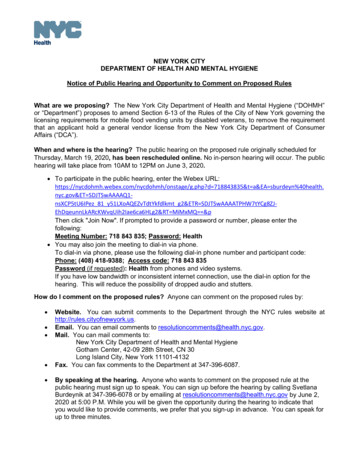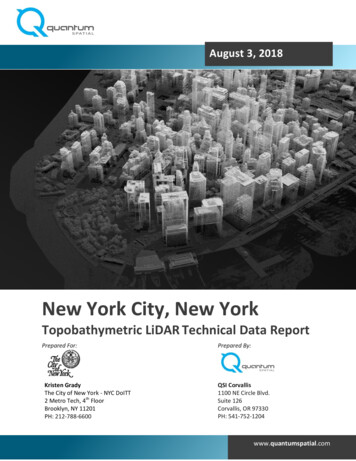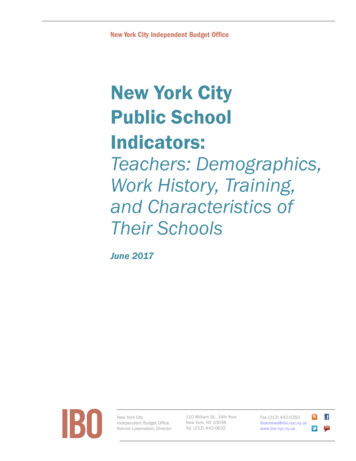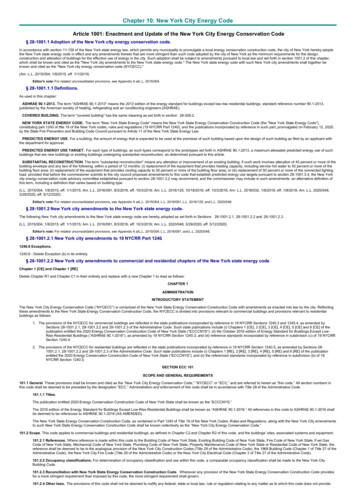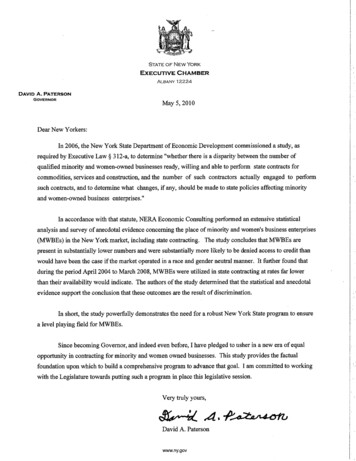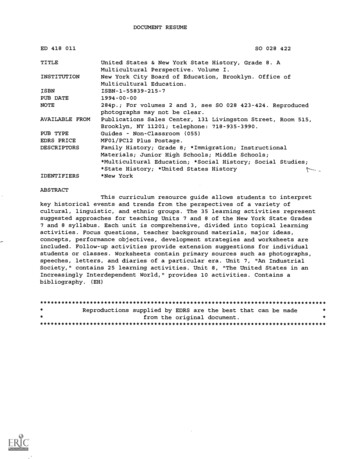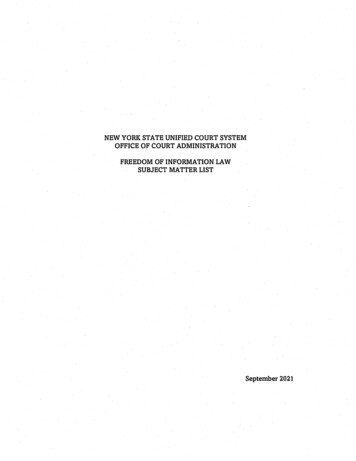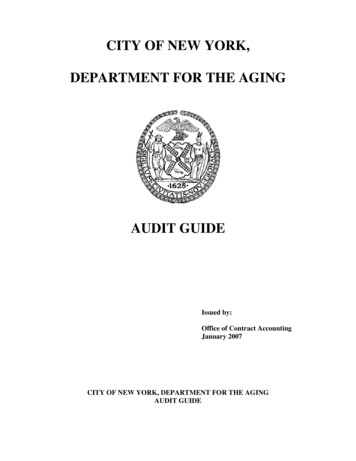
Transcription
CITY OF NEW YORK,DEPARTMENT FOR THE AGINGAUDIT GUIDEIssued by:Office of Contract AccountingJanuary 2007CITY OF NEW YORK, DEPARTMENT FOR THE AGINGAUDIT GUIDE
TABLE OF CONTENTSSECTIONREF.SECTION 100 - ADMINISTRATION AND OVERVIEWPurpose and Effective Date of Audit Guide101Audit Report Delivery102Audit Report Corrections103Who to Contact for Assistance104Auditor Independence Requirements105CPE and External Quality Control Review106Auditor Referral - Inadequate Work107Auditor Invoicing to DFTA108Auditor Progress Reports to DFTA109SECTION 200 - SUMMARY OF APPLICABLE LITERATUREGeneral Information201American Institute of Certified Public Accountants202General Accounting Office203Office of Management and Budget204City of New York, Department for the Aging205SECTION 300 - GENERAL AUDITING STANDARDS AND REQUIREMENTSIntroduction301Working Papers302Audit Planning303Testing of Compliance with Laws and Regulations304Audit Sampling305
CITY OF NEW YORK, DEPARTMENT FOR THE AGINGAUDIT GUIDETABLE OF CONTENTSSECTIONREF.SECTION 300 (CONT.)Questioning of Costs306Disclosure of Possible Irregularities and Illegal Acts307Follow-Up on Prior Audit Report Findings308Written Representations from Management309Exit Conference310DFTA Audit on Current Year Contract when Prior Contract(s)were not Audited311SECTION 400 - SPECIFIC AUDITING REQUIREMENTSPreliminary Work401Financial Management402Audit of Costs - General Requirements403Payroll and Fringe Benefits404Consultants405Occupancy (Rent Expense, Utilities, Other Occupancy)406Equipment/Renovations, Supplies and Materials407Travel408Food409Other Direct Costs410One-Time Payments411Indirect Costs412In-Kind Costs413
CITY OF NEW YORK, DEPARTMENT FOR THE AGINGAUDIT GUIDETABLE OF CONTENTSSECTIONREF.SECTION 400 (CONT.)Contribution Revenues/Expenses414Homecare Fees Billed, Collected and Receivable415Performance Based Contracts416Compliance with Quantified Program Objectives417Verifications of Service Units by HoursCase AssistanceCase ManagementCongregate MealsCounselingEducation and RecreationEscortFriendly VisitingHealth PromotionHome Delivered MealsHomemaker/Personal phone ReassuranceResidential RepairLegal AssistanceIntergenerational ServiceHeavy Duty CleaningNutrition EducationShopping Assistance/ChoreCrime Victims Assistance/Crime Prevention ServicesWRAPCaregiverSocial Adult Day Services (SADS)Follow-Up of Prior Period Audit 18Additional Audit Matters419
CITY OF NEW YORK, DEPARTMENT FOR THE AGINGAUDIT GUIDETABLE OF CONTENTSSECTIONREF.SECTION 500 - AUDIT REPORTING - STANDARDS AND REQUIREMENTSGeneral Information501Financial Statements502Supplemental Information503Internal Control and Compliance504Illustrative Audit Reports505Sample Report on Common Sponsor Deficiencies506Appendix AAppendix BSECTION 600 - AGREED-UPON PROCEDURESBackground601Monitoring Agreed-Upon Procedures602Agreed-Upon Procedures Report on Monitoring Procedures UnderSection 602 of the DFTA Audit Guide603Agreed-Upon Procedures Report on Procedures Specified by DFTA604SECTION 700 – SAMPLE AUDIT REPORT – FOR PROFIT AGENCYSECTION 800 - DFTA REPORT REVIEW CHECKLIST
SECTION 100ADMINISTRATION AND OVERVIEWSECTION 101 - PURPOSE AND EFFECTIVE DATE OF AUDIT GUIDE.01 The purpose of the City of New York, Department for the Aging Audit Guide is toimplement the Department for the Aging (DFTA) audit requirements to be utilized byindependent auditors in preparing for and performing audits of contract agencies which receivecontracts from DFTA. The Audit Guide is intended to be a reference source for the independentauditor. The Audit Guide is comprised of the following sections: Section 100 - Administration and Overview Section 200 - Summary of Applicable Literature Section 300 - General Auditing Standards and Requirements Section 400 - Specific Auditing Requirements Section 500 - Audit Reporting Standards and Requirements Section 600 - Agreed-Upon Procedures and Reporting Section 700 - DFTA Report Review Checklist.02This Audit Guide supersedes any previous audit guides issued by DFTA.03This Audit Guide is not a complete manual of procedures nor should it supplant theauditor's judgment of the audit work required in a particular situation. Because of thevariety of DFTA programs and the associated types of funding and the complexity of theregulations that govern them, the procedures contained in this Audit Guide cannot cover allcircumstances or conditions that would be encountered in an audit of every contractagency. The auditor should use professional judgment to tailor their procedures to meet theconditions of the particular engagement so that the audit objectives may be achieved.04The provisions of this Audit Guide are effective upon publication and shall apply to auditsof contract agencies which DFTA has selected for audit.SECTION 102 - AUDIT REPORT DELIVERY.01Six copies of the completed audit report (as required under Section 500 of this AuditGuide) is due to DFTA within 90 days after the auditor’s receipt of the DFTA preparedrevenue statement and associated contract closeout data or the registration of the auditfirm’s contract, whichever is later.02Six copies of an agreed-upon procedures report (Section 600 of this Audit Guide) are to bedelivered in accordance with the time frame established by DFTA.100-1 (Rev. 01/07)
SECTION 102 - (CONT.).03In addition to the previously mentioned reports, for common sponsor lot audits, (i.e., auditsof DFTA agencies administered by one sponsor), the auditor is required to prepare andsubmit a report which summarizes all internal control structure and compliance findingscommon to two or more of the agencies administered by that sponsor. The summaryreport on internal control structure and compliance must be submitted at the time the finalreports are submitted. If there are no common deficiencies, the summary report mustcontain a positive statement to that effect. This requirement is in addition to the reports oninternal control structure and compliance submitted with the required audit reports on eachagency. The form of the report is provided in Section 506.04The copies of the reports are to be delivered by the close of business to the:Office of Contract AccountingDepartment for the AgingCity of New York2 Lafayette Street – 9th FloorNew York, New York 10007-1392Report Delivery Extensions.05If the auditor believes that an extension of the deadline for submission of the report isnecessary, the request must be in writing and be specific in nature. The reasons for therequest and the expected delivery date must be stated.06The request for extension should be received by DFTA as soon as the auditor becomesaware of the need for an extension and at least 45 calendar days prior to the date the reportis due.SECTION 103 - AUDIT REPORT CORRECTIONS.01Auditors must address all issues transmitted by DFTA on its deficiency letters by eithermaking appropriate corrections or stating reason(s) why a correction(s) was not made.Audit Report Corrections Delivery.02Six copies of the completed audit report or page are due to DFTA within seven (7) calendardays or as specified on DFTA’s correspondence, which is transmitted either via e-mail orfax and U.S. mail.SECTION 104 - WHO TO CONTACT FOR ASSISTANCE.01In preparing for or conducting an audit, the independent auditor may have questionswhich arise concerning the implementation of the requirements of this Audit Guide.These questions should be directed to the Director of Contract Accounting at DFTA orhis/her designee.100-2 (Rev. 01/07)
SECTION 105 - AUDITOR INDEPENDENCE REQUIREMENTS.01In all matters relating to the audit work, the audit firm and the individual auditors shouldbe free from personal and external impairments to independence, and should maintain anindependent attitude and appearance.02No person may audit any organization in which the auditor, audit firm member or anymember of his or her immediate family, is a member of the Board of Directors, is anofficer or employee or has any other direct or indirect interest in the organization orprogram to be audited.03No auditor or firm of auditors that has been engaged to audit an organization or program orany member of his or her immediate family, may engage in any business transactions orserve as a member of the Board of Directors or serve as an officer or employee of theorganization or program during the period of audit performance.SECTION 106 - CPE AND EXTERNAL QUALITY CONTROL REVIEW.01Audits performed in accordance with the DFTA Audit Guide are to conform to therequirements established in Government Auditing Standards. Those standards in partrequire the auditor and the audit firm to possess adequate competence and have appropriatequality assurance systems. Specifically: Section 3.39 requires: “The staff assigned to perform the audit or attestationengagement should collectively possess adequate professionalcompetence for the tasks required.” Section 3.45 requires: “Auditors perform work under GAGAS, including planning,directing, performing fieldwork, or reporting on an audit orattestation engagement under GAGAS, need to maintain theirprofessional competence through continuing professionaleducation (CPE). Therefore, each auditor performing workunder GAGAS should complete, every 2 years, at least 80hours of CPE that directly enhance the auditor’s professionalproficiency to perform audits and/or attestation engagements.At least 24 of the 80 hours of CPE should be in subjectsdirectly related to government auditing, the governmentenvironment, or the specific or unique environment in whichthe audited entity operates. At least 20 hours of the 80 shouldbe completed in any 1 year of the 2-year period.” Section 3.49 requires: “Each audit organization performing audits and/or attestationengagements in accordance with GAGAS should have anappropriate internal quality control system in place and shouldundergo an external peer review.” Section 3.52 requires: “Audit organizations performing audits and attestationengagements in accordance with GAGAS should have anexternal peer review of their auditing and attestation100-3 (Rev. 01/07)
engagement practices at least once every 3 years by reviewersindependent of the audit organization being reviewed. Theexternal peer review should determine whether, during theperiod under review, the reviewed audit organization’s internalquality control system was adequate and whether qualitycontrol policies procedures were being complied with toprovide the audit organization with reasonable assurance ofconforming with applicable professional standards. Auditorganizations should take remedial, corrective actions asneeded based on the results of the peer review.”.02Auditors or audit firms which do not meet Government Auditing Standards, such ascontinuing professional education or external quality control review, need to disclose in theauditor’s reports those audit standards are not met. These auditor’s reports will not beaccepted by DFTA.100-4 (Rev. 01/07)
SECTION 107 - AUDITOR REFERRAL - INADEQUATE WORK.01Where a review of the audit report or the working papers, as performed by anyrepresentatives of DFTA and/or City of New York, discloses an inadequacy, the audit firmwill be contacted. Where such inadequacies are deemed significant and the associatedworking papers are deemed substandard, the City of New York may proceed with furtheraction against the particular auditor and/or audit firm.02In those instances where the audit was performed by a certified public accountant and thework was determined to be substandard by the City of New York, the matter may besubmitted to the City of New York, Controllers Office and/or the New York StateEducation Department, Office of the Professions, Professional Licensing Services and theNew York State Society of Certified Public Accountants.SECTION 108 - AUDITOR INVOICING TO DFTA.01The independent auditor is to invoice DFTA separately for each DFTA audit, monitoringvisit, or agreed-upon procedures. The invoice must specify the following: .02Type of work performedName of the DFTA agencyDFTA I.D. number, contract number and lot numberPeriod of audit, monitoring or agreed-upon proceduresBilling information/summary:a. Name of auditorb. Staffing categoryc. Actual hours expendedd. Contracted hourly ratee. Amount of labor cost (c. x .d)f. Total amount invoiced to DFTA (not to exceed bid maximum)Each invoice to DFTA must include the certification specified below and signed and datedby an authorized individual of the accounting firm (partner/principal/officer).We (I) certify that the services described and the number of hours stated in this invoicehave been performed in accordance with the agreement between the Department For theAging of the City of New York and (Name of Accounting Firm).(Print name)(Signature).03DateThe management/supervisory and staff personnel listed on the auditor’s invoice to DFTAmust agree to the names and staffing categories of the individuals whose resumes weresubmitted to DFTA in the auditor’s proposal. Any additions or staffing category changesto that proposal would require a resume to be submitted to DFTA for approval prior to theprocessing of an invoice for payment.100-5 (Rev. 01/07)
SECTION 109 - AUDITOR PROGRESS REPORTS TO DFTA.01A status report must be submitted by each auditor/firm to DFTA on a bi-weekly basis,beginning two weeks after the start of the contract with DFTA. This status report, whichwould cover audits or monitoring visits and must be submitted until the completion anddelivery of all audit reports, is required to have the following information on each lot andeach agency in the lot. Name of accounting firmReporting periodLot numberDFTA ID numberSponsor nameProgram nameAudit or monitoring periodContract registration dateDate DFTA Revenue Statement (RS) package receivedAudit or monitoring scheduled start dateDate audit or monitoring started% of work completed as of date of progress reportReport due dateDFTA approved report extension due dateExit conference dateDate report delivered to DFTAComment, if any, regarding delays in report submission. This comment(s)cannot be used as an extension request. (Refer to Report DeliveryExtensions, Section 102·05 when such request may deem necessary).A sample of the above status report is provided in Section 108.3.02The above status report must cover a two-week period ending on a Friday and is to besubmitted to DFTA no later than 3:00 p.m. on the following Wednesday. This reportmay be transmitted to DFTA as follows:Via facsimile (FAX) at (212) 442-1027 and followed by hard copy.orE-mail: gcampbell@aging.nyc.govjpierre@aging.nyc.gov100-6 (Rev. 01/07)
XYZ Accounting FirmAudit (1) Status Report as of July XX, 19XXLot Number XXDFTA IDNumber(1)Sponsor/ProgramNameAudit eduledStart DateDate WorkCommenced% of WorkCompletedReportDue DateDFTAApprovedExt. Date onExitConferenceDateIf monitoring visits are to be reported for a specific lot, then amend appropriately to include audit and/or monitoring.100-7 (Rev. 01/07)Date ReportDelivered toDFTAComments
SECTION 200SUMMARY OF APPLICABLE LITERATURESECTION 201 - GENERAL INFORMATION.01In performing a DFTA contract type audit at a not-for-profit or for-profit organization,the Statements on Auditing Standards (SAS's) are applicable. Therefore, the auditorshould perform the audit, at a minimum, in accordance with generally accepted auditingstandards. However, in audits for the City of New York, Department for the Aging, thereare numerous other official publications of which the auditor must be knowledgeable, andthe auditor must perform the audit in accordance with the provisions of these additionalregulations. The AICPA recognized these additional standards and/or procedures andconcluded the following in Ethics Ruling 501-3:Failure to follow standards and/or procedures or other requirements ingovernmental audit. Engagements for audits of government grants, governmentunits or other recipients of government monies typically require that such audits bein compliance with government audit standards, guides, procedures, statutes, rulesand regulations, in addition to generally accepted auditing standards. If a memberhas accepted such an engagement and undertakes an obligation to follow specifiedgovernment audit standards, guides, procedures, statutes, rules and regulations, inaddition to generally accepted auditing standards, he is obligated to follow suchrequirements. Failure to do so is an act discreditable to the profession in violationof Rule 501, unless the member discloses in his report the fact that suchrequirements were not followed and the reasons therefore.02Failure to follow the standards and/or procedures contained in the publications listed inSections 202 to 205 of this Audit Guide, without disclosure in the auditor's report, will bea violation of Ethics Rule 501. In addition, reference in the auditor's report that the auditwas conducted in accordance with the provisions of the City of New York, Departmentfor the Aging Audit Guide incorporates the applicable provisions of the publicationscited in Sections 202 to 205 as well as the other applicable pronouncements promulgatedby the Financial Accounting Standards Board (FASB) and the AICPA.03The auditor should obtain and become familiar with the following publications prior toauditing the programs of the DFTA contract agency. The following is a summary of eachpublication. This summary is provided for informational purposes only. The auditorshould refer to the actual publication for guidance.SECTION 202 - AMERICAN INSTITUTE OF CERTIFIED PUBLIC ACCOUNTANTS (AICPA).01Statements on Auditing Standards (SAS). Issued by the Auditing Standards Board andrepresents generally accepted auditing standards. "Rule 202 of the AICPA's Code ofProfessional Ethics requires adherence to generally accepted auditing standards,recognizes Statements on Auditing Standards as interpretations of those standards, andrequires that members be prepared to justify departures." In addition, the followingstatements on auditing standards are critical in the performance of a DFTA audit andmust be understood and utilized by the auditor.200-1 (Rev. 01/07)
SECTION 202 (CONT.).02SAS No. 53 - The Auditor's Responsibility to Detect and Report Errors and IrregularitiesThis Statement provides guidance on the independent auditor's responsibility for thedetection of errors and irregularities in an audit of financial statements in accordance withgenerally accepted auditing standards. It describes factors that influence the auditor'sability to detect errors and irregularities and explains how the exercise of due care shouldgive appropriate consideration to the possibility of errors or irregularities. It alsoprovides guidance on the auditor's responsibility to communicate detected matters bothwithin and outside the entity whose financial statements are under audit.03SAS No. 54 - Illegal Acts by ClientsThis Statement prescribes the nature and extent of the consideration an independentauditor should give to the possibility of illegal acts by a client in an audit of financialstatements in accordance with generally accepted auditing standards. The Statement alsoprovides guidance on the auditor's responsibilities when a possible illegal act is detected.04SAS No. 55 - Consideration of the Internal Control Structure in a Financial StatementAudit (As amended by SAS No. 78)This Statement provides guidance on the independent auditor's consideration of anentity's internal control structure in an audit of financial statements in accordance withgenerally accepted auditing standards. It describes the elements of an internal controlstructure and explains how an auditor should consider the internal control structure inplanning and performing an audit.05SAS No. 74 - Compliance Auditing Considerations in Audits of Governmental Entitiesand Recipients of Governmental Financial AssistanceThis Statement is applicable when an auditor is engaged to audit a governmental entityunder generally accepted auditing standards (GAAS), and engaged to test and report oncompliance with laws and regulations under Government Auditing Standards (the YellowBook) or in certain other circumstances involving governmental financial assistance, suchas single or organization-wide audits or program-specific audits under certain federal orstate audit regulations.The SAS provides general guidance to the auditor to:a.Apply the provisions of AU Section 317, Illegal Acts by Clients, relative to detectingmisstatements resulting from illegal acts related to laws and regulations that have a directand material effect on the determination of financial statement amounts in audits of thefinancial statements of governmental entities and other recipients of governmentalfinancial assistance.200-2 (Rev. 01/07)
SECTION 202 (CONT.)b.Perform a financial audit in accordance with Governmental Auditing Standards, issued bythe Comptroller General of the United States.c.Perform a single or organization-wide audit or a program-specific audit in accordance withfederal audit requirements.d.Communicate with management if the auditor becomes aware that the entity is subject toan audit requirement that may not be encompassed in the terms of his or her engagement.06SAS No. 99 - Consideration of Fraud in a Financial Statement AuditThis statement provides guidance to auditors in fulfilling that responsibility, as it relates to fraud,in an audit of financial statements conducted in accordance with generally accepted auditingstandards. Specifically, this statement: Describes fraud and its characteristics. Requires the auditor to plan and perform the audit to obtain reasonable assurance aboutwhether the financial statements are free of material misstatement, whether caused byerror or fraud. Describes the importance of exercising professional skepticism including a discussionamong engagement personnel regarding the risks of material misstatement due tofraud. Provides guidance on how the auditor obtains the information needed to identify risksof material misstatement due to fraud. Requires that in considering fraud risk factors the auditor should conduct inquiries ofmanagement and others within the organization. Provides guidance on the evaluation of audit test results as they relate to the risk ofmaterial misstatement due to fraud. Describes the auditor’s requirement to assess the identified risks after taking intoaccount the organization’s controls. Provides guidance regarding the auditor’s communication about fraud to management,the audit committee, and others.SAS No. 99 is effective for audits of financial statements for periods ending on or afterDecember 15, 2002.07 SAS No. 112 – Communicating internal control related matters identified in an audit.a. SAS 112 requires the auditor to communicate, in writing, to management and thosecharged with governance, significant deficiencies and material weaknesses identified in200-3 (Rev. 01/07)
an audit.200-4 (Rev. 01/07)
SECTION 202 (CONT.)b. The following definitions are provided in the SAS: Control deficiency – A control deficiency exists when the design or operation of acontrol does not allow management or employees, in the normal course ofperforming their assigned functions, to prevent or detect misstatements (notnecessarily material misstatements) on a timely basis.Significant deficiency – A control deficiency or combination of controldeficiencies that adversely affects the entity’s ability to initiate, authorize, record,process or report financial data reliably in accordance with GAAP, such that thereis more than a remote likelihood that a misstatement of the financial statementsthat is more than consequential will not be prevented or detected.Material weakness – A significant deficiency, or combination of significantdeficiencies, that results in more than a remote likelihood that a materialmisstatement of the financial statements will not be detected or prevented.The standard used to measure the difference between a significant deficiency anda material weakness is clearly subjective and up to the judgment of the auditorand is based on a consideration of both quantitative and qualitative factors. Theterm “more than inconsequential” relates to the magnitude of the error but is notthe equivalent of materiality determinations or tolerable error rates.The significance of a control deficiency depends upon the potential formisstatement and not on whether or not a misstatement actually occurred.SAS 112 is effective for years ending on or after December 15, 2006.08 All future pronouncements that will be issued by the AICPA that are applicable to auditing(as they relate to DFTA programs) are to be adhered to by the auditor.200-5 (Rev. 01/07)
SECTION 203 - GENERAL ACCOUNTING OFFICE (GAO).01 Government Auditing Standards (2003 Revision)The standards and guidance in this document apply to audits and attestation engagements ofgovernment entities, programs, activities, and functions, and of government assistanceadministered by contractors, nonprofit entities, and other nongovernmental entities. Anumber of statues and other mandates require that auditors follow GAGAS. Where a statuteor other mandate does not exist, auditors will find it useful to follow GAGAS in workregarding the use of government funds. If auditors hold themselves out as followingGAGAS, regardless of whether the auditors are required to follow such standards, theauditors need to justify any departures from GAGAS.02 Interpretation of Continuing Education and Training RequirementsThis interpretation guides audit organizations and individual auditors on implementing theCPE requirements by answering the most frequently asked questions from the auditcommunity.03 Assessing Compliance With Applicable Laws and RegulationsThe guide is designed to assist the auditor in implementing the requirement for detectingnoncompliance. The guide provides a general overview of compliance testing, discusseshow audit assignment objectives influence compliance testing, and explains how to identifyapplicable laws and regulations. It also explains how to perform a vulnerability assessment,compliance testing and reporting requirements for performance audits, and the requirementsfor financial audits.SECTION 204 - OFFICE OF MANAGEMENT AND BUDGET (OMB).01 OMB CircularsThe Office of Management and Budget has developed and published a series of financialcirculars which establish uniform policies and regulations to be observed by all executivebranch agencies of the Federal Government. The following lists some of those circulars theindependent auditor should consider during the conduct of the audit.02 Office of Management and Budget Circular A-21, Cost Principles for EducationalInstitutions Issued May 8, 1996, Revised May 10, 2004The Circular establishes principles for determining costs applicable to grants, contracts and otheragreements with educational institutions. The significant areas covered by the Circular include: Principles for determining costs applicable to grants, contracts, and other agreements,including definition of direct and indirect costs along with the requirements for costallocation plans; andStandards for selected items of cost.200-6 (Rev. 01/07)
SECTION 204 (CONT.).03 "Office of Management and Budget Circular A-110, Uniform Administrative Requirementsfor Grants and Agreements with Institutions of Higher Education, Hospitals and OtherNonprofit Organizations Revised November 29, 1993, Amended September 30, 1999This Circular sets forth standards for obtaining consistency and uniformity among Federalagencies in the administration of grants to and agreements with institutions of higher education,hospitals, and other nonprofit organizations.The provisions of the sections of this Circular shall be applied by Federal agencies to recipients.Recipients shall apply the provisions of this Circular to subrecipients performing substantivework under grants and agreements that are passed through or awarded by the primary recipient.This Circular does not apply to grants, contracts, or other agreements between the FederalGovernment and units of State or local governments covered by OMB Circular A-102, "Grantsand Cooperative Agreements with State and Local Governments," and the Federal agencies'grants management common rule which standardized and codified the administrativerequirements Federal agencies impose on State and local grantees. In addition, subawards andcontracts to State or local governments are not covered by this Circular. However, this Circularapplies to subawards made by State and local governments to organizations covered by thisCircular.04 Office of Management and Budget Circular A-122, Cost Principles for Non-ProfitOrganizations (With revisions up to May 10, 2004)The Circular establishes principles for determining costs of grants, contracts and otheragreements with not-for-profit organizations. It does not apply to state and local governments,which are covered by Circular A-87. The significant areas covered by the Circular include: Principles for determining costs applicable to grants, cooperative agreements, costreimbursement contracts, including definition of direct and indirect costs along with therequirements for cost allocation plans; and Standards for selected items of cost, including allowable costs and unallowable costs.SECTION 205 - CITY OF NEW YORK, DEPARTMENT FOR THE AGING.01 Fiscal Management ManualThe City of New York, Department for the Aging Contract Agency Fiscal ManagementManual (revised August 2005) is a reference document. The purpose of this manual is toassist personnel in properly carrying out
SECTION 101 - PURPOSE AND EFFECTIVE DATE OF AUDIT GUIDE.01 The purpose of the City of New York, Department for the Aging Audit Guide is to implement the Department for the Aging (DFTA) audit requirements to be utilized by independent auditors in preparing for and performing audits of contract agencies which receive contracts from DFTA.


